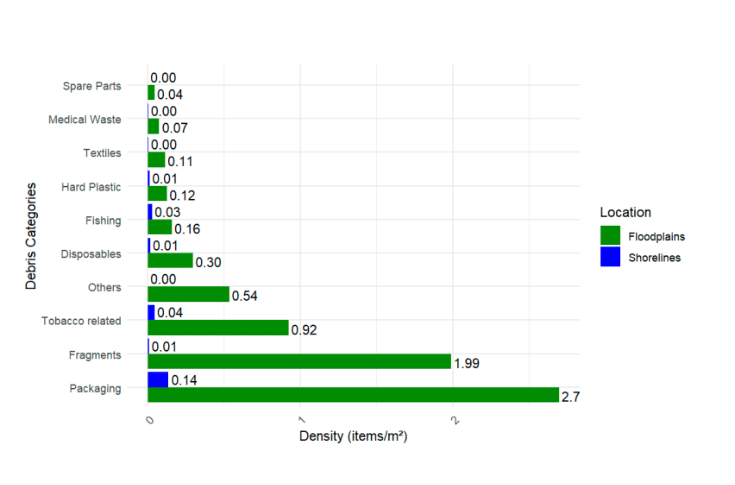Packaging waste dominates pollution in high biodiversity zone stretch of Ganga: Study
The study which published in the journal Sustainability notes the dominance of single-use wrappers and bags in plastic pollution; It also details how floods cyclically replenish the plastic burden, particularly in the river’s high-biodiversity zone where nearly two-thirds of all waste was found
29 Sep 2025 | 974 Views | By Sai Deepthi P
A new scientific survey by researchers from the Wildlife Institute of India (Published August 2025) documented 37,730 debris items along a 76-kilometre stretch of the Ganga River in Sahibganj, Jharkhand. It has revealed the prevalence of packaging plastics as the leading form of pollution.
Key Highlights from the study
- Urban centres have waste systems; rural areas lack segregation and disposal, leading to dumping into rivers
- Ritual offerings in plastic add to river pollution
- Packaging (43%) and fragments (21%) dominate, posing physical (entanglement, ingestion) and chemical (toxic leaching) risks
- 2.9% of fishing-related debris in biodiversity zones; major threat to Gangetic dolphins and otters
Packaging waste accounted for 52.4% while plastic fragments were the second-largest category of polluters at 23.3%; Single-use cutlery such as cups, spoons and plates were at 4.7%. Fishing gear, textiles and medical plastics were also present in smaller amounts.

Nightlight analysis conducted over the past decade traced a rapid expansion of urban centres right along the riverbanks, exacerbating pollution by fostering a cultural switch towards single-use items. The study also notes a major lack of infrastructure for waste management outside municipal limits.
Despite the assumption that urban litter would exceed rural pollution, detailed statistical analysis showed that household waste dominates everywhere, and higher plastic accumulation in floodplains is directly tied to the absence of affordable bulk purchases in low-income communities.
One of the most distinctive findings was the identification of “ghost fishing gear”—lost or discarded nets and Styrofoam—making up more than 70% of fishing-related debris in the high-biodiversity segment. This poses a persistent threat of entanglement for endangered river fauna like the Gangetic dolphin and smooth-coated otter, while also acting as potent carriers of toxic contaminants, further imperilling aquatic life.
Moreover, the study found evidence of reciprocal waste pollution, with plastic debris being exchanged between the Ganga and the Udhwa Bird Sanctuary via connecting channels, endangering migratory and resident bird populations in the protected wetland zone.
Furthermore, the research warns that current and recent legislative bans on single-use plastics, though promising, face steep obstacles in effective implementation and public buy-in, especially outside cities.The study recommends stronger waste systems, EPR, plastic tax, community awareness, innovation in biodegradable materials.
Sources of Debris
Household waste such as shampoo sachets, wrappers, bags dominates (87%)
Religious waste such as packaging of incense, and offerings (2.6%)
Fishing gear such as nets, Styrofoam (4.5%)
Floodplain Composition
Packaging debris (38.8%) is the single largest category
Fragments (28.6%)
Tobacco-related (13.3%)